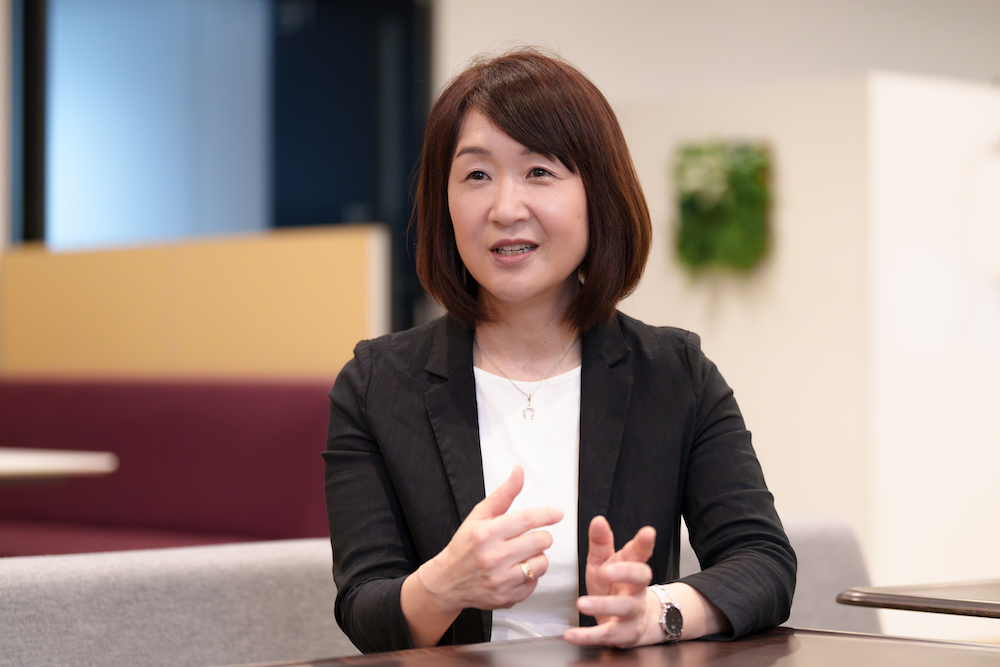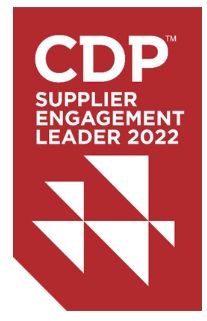Making carbon neutrality a reality with suppliers -Working throughout the value chain to reduce greenhouse gas emissions
2024/03/01 Toshiba Clip Team
- Reducing greenhouse gas emissions throughout the value chain is a global trend
- Where does Toshiba stand today in its pursuit of carbon neutrality in collaboration with primary suppliers?
- Recognized as a “Supplier Engagement Leader,” CDP’s highest rating — voices from front lines.

In early June 2023, a powerful typhoon caused a series of torrential downpours in Japan, with record amounts of rainfall hitting eight prefectures. Scientists say “Due to warming of the atmosphere, it retains more moisture. Climate change is increasing the risk of such heavy rainfall.”
Climate change is now impacting all of our lives, and solving it is a global challenge. Countries around the world have committed to carbon neutrality, however they are struggling to reduce GHGs (greenhouse gases). This is also true for companies, and the key to their efforts is “emissions throughout the chain.” Companies must draw up roadmaps based not only on their own GHG emissions, but also on an understanding of the entire value chain (total emissions and proportion of emissions by source), from upstream (e.g., procurement) to downstream (e.g., sales).
In 2020, Toshiba developed Toshiba Group Environmental Future Vision 2050. As such, the entire company is pursuing environmental business management, with reductions of GHG emissions as the centerpiece initiative. However, in terms of GHG reductions across the value chain, it is still in the process of examining the exact methods. So, where does Toshiba stand today in its efforts to reduce GHG emissions, and what is the Pole Star it should follow to secure a sustainable future for people and the planet? We spoke to Kyoko Fukushima of Environment Management Office, which looks at GHG reductions throughout the value chain, and Emiko Shinohara, who works on supply chain management in Procurement Division, about the first steps toward GHG reduction and the outlook for the future.

Toshiba aims to achieve carbon neutrality throughout the value chain by 2050
Why now is the time to think about GHG reductions throughout the value chain?
To achieve carbon neutrality, companies are trying to ascertain both their own GHG emissions and those of their value chains as a whole. In order to accurately determine the amount of GHGs emitted in the production of a single product, companies need to consider not only manufacturing, but also the entire product life cycle, including the production and procurement of raw materials, logistics, sales, use, and disposal.
The GHG Protocol, an international standard for calculating GHG emissions, defines GHG emissions from a company’s own business activities as Scope 1 and indirect emissions from the use of electricity, heat, and steam supplied by other companies as Scope 2. Scope 3, meanwhile, is the key to understanding emissions in the value chain. Fukushima, who is engaged in environmental activities at Toshiba, discusses the developments surrounding Scope 3.

Main greenhouse gas (GHG) emission categories, with Scope 3 Category 1 circled in red
“Scope 3 refers to indirect emissions other than Scope 1 and 2, that is, emissions generated by other companies in relation to a company’s own business. For companies with a large value chain, like Toshiba, Scope 3 accounts for a large proportion of emissions, so there is a strong imperative for reductions in this area. Scope 3 is further subdivided into 15 categories, and one of the most important categories for manufacturers is “Purchased Products and Services.”
In order to identify emissions from “Purchased Products and Services,” and make reductions accordingly, it is very important to collect GHG emissions data from our suppliers. We are working with multiple departments within the company to reduce GHG emissions throughout the value chain, and with respect to implementation in the supply chain, which represents the upstream of the value chain, we are working together with Shinohara and her colleagues in the Procurement Division.” (Fukushima)

Kyoko Fukushima, Expert, Environment Management Office, Corporate Production Planning Division, Toshiba Corporation
If reductions in GHG emissions are postponed, there will be corresponding delays in achieving carbon neutrality — this sense of crisis and urgency is shared by companies around the world. Accordingly, they have started consulting their suppliers to take specific action.
“Activities involving Toshiba’s value chain are just getting started. First, we need to discuss with our suppliers methods for calculating and reducing GHG emissions. The procurement and environmental divisions are working closely together to share their expertise in order to move forward with full-scale initiatives.” (Fukushima)
Requesting a wide range of primary suppliers to respond to the GHG survey
For many years, Toshiba has pursued green procurement, preferentially purchasing products, parts, materials, and services with low environmental impact from suppliers that conduct environmental business management. Keeping this approach, Toshiba has been surveying primary suppliers on their environmental initiatives. Shinohara, who is in charge of these surveys in the Procurement Division, recalls.
“We conducted an online survey of more than 10,000 primary suppliers in the world. Previously, the survey questions focused on the acquisition status of ISO14001*. However, in order to realize Toshiba’s Environmental Future Vision 2050, the questions have been fundamentally updated.
Given the broad scope of Toshiba’s business and the diversity of industries and business categories among our suppliers, we first sought the cooperation of a wide range of primary suppliers with whom we have ongoing business relationships in order to gain a comprehensive understanding of their current initiatives. The fact that we were able to identify suppliers that have set GHG emissions reduction targets and are currently managing their actual results represents significant progress. We are very grateful to all of our suppliers who participated in the survey.” (Shinohara)

Emiko Shinohara, Expert, Supply Chain Management Promotion Group, Procurement Control & Compliance Promoting Department, Procurement Division, Toshiba Corporation
“However, we did not have a sufficient response rate. Our guess is this was due to the way we communicated with our suppliers, the usability of the online survey, and the content of the questions. We are looking into improvements to make the survey easier to complete, whilst ensuring that it does not place a burden on suppliers.
In addition, suppliers who responded that they set Scope 1 and Scope 2 targets and manage their results accordingly were asked to complete a supplementary GHG emissions survey. While verifying the results, we will focus on suppliers in industries with high GHG emissions and those from which we make the largest volume of purchases to further dialog.” (Shinohara)
Shinohara and her colleagues emphasize “sincere communication and dialogue about Toshiba’s way of thinking and its initiatives.” The desire to think and work together with suppliers lies at the root of their work.
Rather than reacting only after being asked to do so by governments, investors, consumers, and other stakeholders, Toshiba will proactively implement environmental business management with future generations in mind. From the standpoint of Environment Management Office, Fukushima says, “We would like to share with our suppliers that proactive climate change measures will lead to increased corporate value, and to promote the reduction of GHGs originating from Purchased Products and Services.” To this end, it is also important to make sure that everyone at Toshiba is on the same page.”
“It is Toshiba’s individual business units that deal with suppliers on a day-to-day basis. As such, the success or failure of these initiatives depends on understanding of these initiatives by procurement and environmental staff in each unit. We have been trying to foster awareness by holding information sessions to share objectives and contents with these personnel.”
“Moreover, it is not only GHG emissions that need to be looked at from an environmental perspective, but also other issues such as water and biodiversity. As these global trends continue to gather momentum, how can we incorporate these aspects into our own activities? There is no end to the discussions I have with Shinohara about this.” (Fukushima)
The Road to Environmental Future Vision 2050 — Partnerships for GHG Reductions
GHG reductions from “Purchased Products and Services” are in the process of being discussed internationally, and the process is one of ongoing trial-and-error. This is the reality of environmental business management in many companies. Toshiba also works to shifts its efforts into a higher gear, and this process has been recognized by outside organizations. In March 2023, CDP, an international non-profit organization, recognized Toshiba as a “Supplier Engagement Leader,” the highest level in its Supplier Engagement Rating, which evaluates engagement with suppliers on climate change.

Toshiba named a Supplier Engagement Leader by CDP
“When I shared the news of this assessment on the company’s internal social media platform, it received many “Likes” from procurement members. We are happy to see tangible results, and it has given us encouragement for our future efforts.” (Shinohara)
“I think that perceptions will change not just within Toshiba, as Shinohara mentioned, but also on the part of our suppliers. The hope is that it will make it easier to proceed with GHG reduction activities. However, CDP keeps revising the content of the survey from year to year to keep up with global trends. We will continue to develop our activities on a daily basis, without being too concerned about the assessment for any single year.” (Fukushima)

As environmental and social issues become increasingly complex, companies need to solve problems in a way that is integrated with their business strategies. To build a sustainable environment and society and to promote sustainable corporate growth in both, Environment Management Office and Procurement Division are making steady progress toward the year 2050. Finally, let’s hear what both experts have to say, including their personal thoughts.
“The key will be partnership between Procurement Division and Environment Management Office, between Headquarters and each business unit, and with suppliers and other companies in the same industry. Since there is no precedent for this within the company, the allocation of roles and the way to proceed are still being explored and defined, but nothing will move forward if we keep waiting for each other to make a move, and nothing will get done if we insist on perfection. As the world moves at a faster pace, we will start with what we can do right in front of us. Although there are difficulties, I also feel that there is an exciting aspect to it in terms of experimentation through hands-on experience.” (Shinohara)
“As Shinohara says, I want to see us create value together with our suppliers, in terms of reducing GHG emissions, by taking a collaborative approach, rather than simply asking them to do something for us. Toshiba offers a variety of technologies to help achieve carbon neutrality, ranging from energy to power semiconductors that facilitate energy conservation. In other words, our suppliers come from various different industries, and so emission reduction strategies will vary accordingly. I look forward to further collaborating with our suppliers to achieve mutual understanding.” (Fukushima)
The challenge of reducing GHG emissions extends from the company to the value chain, from industry to society. Through the quiet determination and perspective of these two individuals, we can see a GX (Green Transformation: initiatives to balance GHG emissions reduction with competitiveness) approach unique to Toshiba, envisioning a sustainable tomorrow for people and the planet.
*ISO14001: An international standard for environmental management systems established by the International Organization for Standardization (ISO).
![]()
Related Links
*This section contains links to websites operated by companies and organizations other than Toshiba Corporation.
Environmental Future Vision 2050 | Environment | Toshiba






